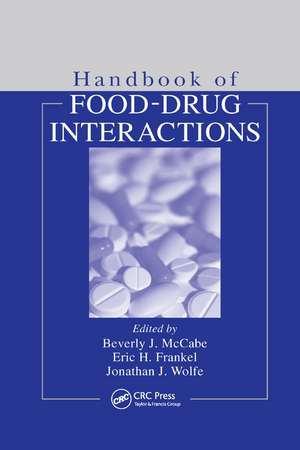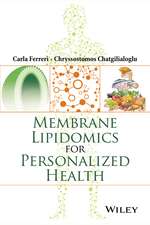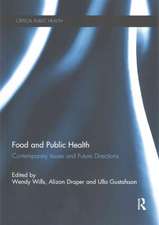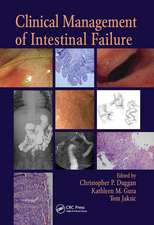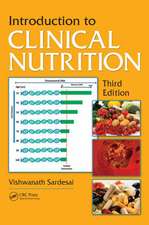Handbook of Food-Drug Interactions: Nutrition Assessment
Editat de Beverly McCabe-Sellers, Eric H. Frankel, Jonathan J. Wolfeen Limba Engleză Paperback – 23 sep 2019
| Toate formatele și edițiile | Preț | Express |
|---|---|---|
| Paperback (1) | 506.10 lei 6-8 săpt. | |
| CRC Press – 23 sep 2019 | 506.10 lei 6-8 săpt. | |
| Hardback (1) | 1299.93 lei 6-8 săpt. | |
| CRC Press – 29 apr 2003 | 1299.93 lei 6-8 săpt. |
Preț: 506.10 lei
Preț vechi: 595.41 lei
-15% Nou
Puncte Express: 759
Preț estimativ în valută:
96.84€ • 101.12$ • 79.97£
96.84€ • 101.12$ • 79.97£
Carte tipărită la comandă
Livrare economică 15-29 aprilie
Preluare comenzi: 021 569.72.76
Specificații
ISBN-13: 9780367395247
ISBN-10: 036739524X
Pagini: 584
Dimensiuni: 156 x 234 x 33 mm
Greutate: 0.92 kg
Ediția:1
Editura: CRC Press
Colecția CRC Press
Seria Nutrition Assessment
Locul publicării:Boca Raton, United States
ISBN-10: 036739524X
Pagini: 584
Dimensiuni: 156 x 234 x 33 mm
Greutate: 0.92 kg
Ediția:1
Editura: CRC Press
Colecția CRC Press
Seria Nutrition Assessment
Locul publicării:Boca Raton, United States
Public țintă
Academic and Professional ReferenceCuprins
Introduction. Pharmacy: Basic Concepts. Biopharmaceutics of Orally Ingested Products. Drug Interactions: Basic Concepts. Nutrition and Metabolism. Food and Nutrition Update. Monitoring Nutritional Status in Drug Regimens. Gastrointestinal and Metabolic Disorders and Drugs. Drug Interactions in Nutrition Support. Alcohol: Interactions with Nutrition and Drugs. Nutrition and Drug Regimens in Older Persons. Obesity and Appetite Drugs. Nonprescription Drugs and Nutrient Interactions. Herbal and Dietary Supplement Interactions with Drugs. Dietary Counseling to Prevent Food-Drug Interactions. Prevention of Drug-Food Interactions. Drug Nutrient Interaction and Joint Commission for Health Care Organizations. Computers in Nutrient-Drug Interaction Management.
Notă biografică
Beverly J. McCabe, Eric H. Frankel, Jonathan J. Wolfe
Recenzii
Review by Norman M. Goldfarb
Handbook of Food-Drug Interactions is an interdisciplinary guide to the prevention and correction of negative food-drug interactions. The book provides explanations and gives spe-cific recommendations based on the frequency and severity of reactions. Substantial research has been conducted since this classic volume was originally published, but the book remains in print because of its lasting value.Some foods and nutritional supplements can change the phys-iological effects of some drugs. Similarly, some drugs can change the nutritional properties of some foods. Over three-quarters of U.S. adults take one or more nutritional supplments, so these cross-effects cannot be ignored in clinical research. The list of foods and nutritional supplements that change the physiological effects of some drugs seems to be endless, and includes the following:•Broccoli and other cruciferous vegetables contain glucosinolates that can inhibit liver enzymes, thereby slowing the metabolism of certain drugs.•Anthocyanins, courmarins, flavanoids, lignans, tannins and other chemicals are ubiquitous in plants. Normal consumption may be harmless but, when concentrated in nutritional supplements, may inhibit liver enzymes and other physiological functions.•Nutritional supplements containing garlic can contain a wide variety of chemicals in various forms, some of which can affect drug metabolism.•Reducing sodium intake can blunt the efficacy of calci-um channel blockers.•The yeast extract, Marmite, can cause hypertension, while other yeast extracts appear not to do so.•Oregano can interfere with fertility drugs.•Licorice extract can increase sodium retention and potassium depletion.•Papaya can increase the effect of warfarin and other anti-coagulants.The book includes 17 chapters from 21 contributors.
Handbook of Food-Drug Interactions is an interdisciplinary guide to the prevention and correction of negative food-drug interactions. The book provides explanations and gives spe-cific recommendations based on the frequency and severity of reactions. Substantial research has been conducted since this classic volume was originally published, but the book remains in print because of its lasting value.Some foods and nutritional supplements can change the phys-iological effects of some drugs. Similarly, some drugs can change the nutritional properties of some foods. Over three-quarters of U.S. adults take one or more nutritional supplments, so these cross-effects cannot be ignored in clinical research. The list of foods and nutritional supplements that change the physiological effects of some drugs seems to be endless, and includes the following:•Broccoli and other cruciferous vegetables contain glucosinolates that can inhibit liver enzymes, thereby slowing the metabolism of certain drugs.•Anthocyanins, courmarins, flavanoids, lignans, tannins and other chemicals are ubiquitous in plants. Normal consumption may be harmless but, when concentrated in nutritional supplements, may inhibit liver enzymes and other physiological functions.•Nutritional supplements containing garlic can contain a wide variety of chemicals in various forms, some of which can affect drug metabolism.•Reducing sodium intake can blunt the efficacy of calci-um channel blockers.•The yeast extract, Marmite, can cause hypertension, while other yeast extracts appear not to do so.•Oregano can interfere with fertility drugs.•Licorice extract can increase sodium retention and potassium depletion.•Papaya can increase the effect of warfarin and other anti-coagulants.The book includes 17 chapters from 21 contributors.
Descriere
While pharmacists may know that a particular drug is inactive in a given pH environment, they often do not know the pH of common foods. For dietitians the situation is reverse. With contributions from pharmacy, dietetics, and medicine, this book serves as a guide to the interdisciplinary prevention or correction of negative food-drug interactions. While other books simply list potential food-drug interactions, this book gives specific recommendations based on frequency and severity of reactions. It provides special dietary modifications necessary for prevention of adverse side effects. It also identifies new foods, supplements, and ethnic dishes that may contribute significantly to food-drug interactions.
